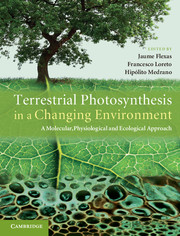 Terrestrial Photosynthesis in a Changing Environment
Terrestrial Photosynthesis in a Changing Environment Book contents
- Frontmatter
- Contents
- List of contributors
- Preface
- Acknowledgements
- List of abbreviations
- 1 Terrestrial photosynthesis in a changing environment
- Part I Photosynthesis
- Part II Measuring photosynthesis
- 9 Gas-exchange analysis: basics and problems
- 10 Optical methods for investigation of leaf photosynthesis
- 11 Stable isotopic compositions related to photosynthesis, photorespiration and respiration
- 12 Mesophyll conductance to CO2
- 13 Biochemical and molecular techniques for the study of photosynthetic processes
- 14 Measuring CO2 exchange at canopy scale: the eddy covariance technique
- 15 Remote sensing of photosynthesis
- Part III Photosynthetic response to single environmental factors
- Part IV Photosynthesis in time
- Part V Photosynthesis in space
- Part VI Photosynthesis in a global context
- References
- Index
13 - Biochemical and molecular techniques for the study of photosynthetic processes
Published online by Cambridge University Press: 05 March 2013
- Frontmatter
- Contents
- List of contributors
- Preface
- Acknowledgements
- List of abbreviations
- 1 Terrestrial photosynthesis in a changing environment
- Part I Photosynthesis
- Part II Measuring photosynthesis
- 9 Gas-exchange analysis: basics and problems
- 10 Optical methods for investigation of leaf photosynthesis
- 11 Stable isotopic compositions related to photosynthesis, photorespiration and respiration
- 12 Mesophyll conductance to CO2
- 13 Biochemical and molecular techniques for the study of photosynthetic processes
- 14 Measuring CO2 exchange at canopy scale: the eddy covariance technique
- 15 Remote sensing of photosynthesis
- Part III Photosynthetic response to single environmental factors
- Part IV Photosynthesis in time
- Part V Photosynthesis in space
- Part VI Photosynthesis in a global context
- References
- Index
Summary
Introduction
Increasing understanding of the many molecular and biochemical processes that respond in a purposive way to the changing environment has given rise to an appreciation that many, if not all, environmental cues evoke primary responses at a molecular level, and that it is these responses that result in changes in gross plant physiology and morphology. Likewise, changes in the relative proportions of metabolites and ions within intracellular compartments in response to such environmental cues also give rise to multiple changes in gene expression. The interaction between these levels of complexity in response to changes in the external environment is illustrated in Scheme 13.1.
This chapter describes and discusses approaches: (1) for the unbiased analyses of gene, protein and metabolite function facilitated by a variety of high-throughput approaches; and (2) for the focused analyses of specific genes, gene products and metabolites. The former approaches seek to identify hitherto unknown genes and molecular interactions, while the latter are used to probe those elements that we currently consider most important in understanding and interpreting how photosynthetic processes relate to ecophysiological questions. In particular, we discuss aspects of the isolation and assay of the carboxylating enzymes, Rubisco and phosphorenolpyruvate carboxylase (PEPC), owing to their pivotal roles in assimilation and to the continuing interest in their measurement. In general, we have selected methods and approaches that have been applied in our laboratories, but acknowledge that many alternative methods could have been described, which are equally reliable and quantitative.
- Type
- Chapter
- Information
- Terrestrial Photosynthesis in a Changing EnvironmentA Molecular, Physiological, and Ecological Approach, pp. 186 - 205Publisher: Cambridge University PressPrint publication year: 2012


